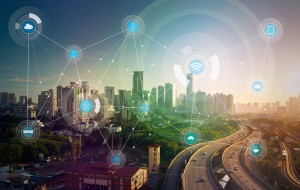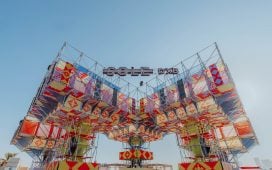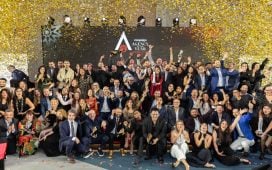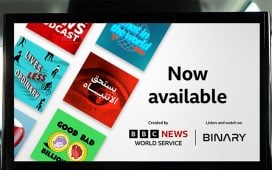
Posterscope’s Federica Fattorusso examines how our urban environments can connect to the messages we see on the streets
As we enter what is being called the fourth industrial revolution, which sees the increasing connection of people to things through the internet, companies are reviewing and repositioning their offering in order to meet this ever-growing social phenomenon. In 2015, 3 billion people in the world were connected to things through their smartphones. About 50 billion people and things are expected to be connected within the next five years, and even perhaps 1 trillion by 2030. This trend is also inevitably accompanied by a significant migration of people to urban cities, cities that are able to make the most of this connectivity, cities that are efficient and ‘smart’. In a world where it is now possible to get anything any time, anywhere, people are seeking environments where this can be done in the fastest, easiest and most comfortable manner.
What does this mean for brands?
As consumers become accustomed to these environments, they become increasingly more demanding and sophisticated. With so much focus on efficiency in every sphere of everyday life, people are keen to filter and select the information they need in the most optimised manner. They seek content that is relevant to them, and engage only in conversations that bring them personal utility. Brands need to address this; they should be having strategic discussions focused on their geo-based audiences, through the help of data and insight, in order to understand and determine which touchpoints to utilise and how best to speak to their audience, communicating their messages while simultaneously supplying a service for their end consumer. They need to move towards a marketing strategy that is focused on location and connectivity.
So what are the opportunities for out-of-home?
Out-of-home has a unique knowledge of where people are, how they feel, what they do, and how and where they do it. It has also been the fastest growing offline medium in the last 10 years, and therefore has an increasingly important role in smart cities. With more and more people out and about, the OOH sphere connects the physical and the virtual world, through the use of mobile, creating an incredible amount of data. This insight is fundamental not only to understanding what and how content is being consumed in relation to geo-location, but also to actually building and optimising smart cities. The out-of-home sector contributes significantly to bringing new formats and innovation to urban areas, which improves the landscape through technology, design and creativity.
One of the biggest challenges brands face today is data. It’s a top-of-mind priority for many companies, yet how to use all the data available in a useful manner is still an issue. As OOH location consultants, our know-how helps our clients filter the data available to them in order to optimise their communication in OOH environments.
In order to do all of this to our best ability, however, we also need support from the wider OOH market. Media suppliers and brands need to be investing in this future through infrastructure, culture and internal platforms, for example. There needs to be a shift in mindset that no longer sees OOH as simply prime media locations, but solutions that pull together geolocation audience data, technology, dynamic content, creativity and strategically chosen touchpoints. Piecing these building blocks together will enable brands to develop new and invaluable marketing solutions, which will in turn allow for constant optimisation of return on investment.
In a market like the UAE, and in a city like Dubai, where development is visible on every horizon, the opportunity for growth towards becoming an increasingly smart city is enormous and we are looking forward to riding this wave.
Smart cities revolve around planning with data and embracing technology in order to make urban living more efficient, cost-effective and, in many cases, more environmentally friendly.
Mobile
Mobile is the glue of smart cities and is at the forefront of technological progress for every industry. With smartphone penetration rising on a daily basis, and the digital consumer increasingly on the move and always connected, presiding over the mobile arena is a top priority for all modern brands. Smartphones are our most intimate and personal devices, and are therefore fundamental to understanding evolving human and consumer behavior. Through proximity sensors that detect the presence of nearby smartphones, OOH now has access to invaluable tracking data sets. When filtered and interpreted, these reveal fundamental social trends from urban mobility to in-store habits. In addition to the data these devices supply, mobile is also key in supplying accountability and measurability to a medium that until yesterday, in its traditional form, had more difficulty in showing calculable results than other mediums. Used as a call to action through technologies such as NFC or QR codes, mobile is now able to work with OOH in stepping closer to delivering an increasingly accurate return-on-investment evaluation for brands investing in OOH environments. Finally, as mobile progressively enables what brands consider to be the most important stage of the consumer cycle, that of the purchase, through e-wallet and pay-as-you-go solutions, their activation power becomes of fundamental relevance within an advertising campaign.
Digital Screens
Smart cities witness digital transformations in all industries, and for OOH this is no less significant. Digital signage is growing in many markets, with suppliers investing in new digital screens as well as digitising traditional formats. For brands, these new sites provide a number of opportunities. While many only think of programmatic buying in relation to dramatically changing the way the medium is being traded, the more immediate results are being seen in terms of content and creativity. New technologies can offer brands the possibility of supplying their consumers with increasingly creative and personalised – and therefore relevant – content. When this capability is paired with the insight provided by supporting technology, the objective of targeted messaging delivered on a mass scale begins to be more attainable.
Sensors
Sensors are the eyes and ears of smart cities. A sensor is a component able to detect a change in its environment and convert this change into an electrical signal. They can pick up various external factors within determined ranges, such as weather conditions, position and acceleration. When integrated with cameras they can return images or image streams. Operating in real time, they can produce large amounts of information, and trigger consequential ‘actions’. They can help monitor vehicle transit, for example, by activating stop lights or lamp posts in order to optimise traffic and energy consumption. In a strictly OOH advertising context on the other hand, sensors can prompt real-time dynamic content on digital media, based on external factors such as temperature, hence increasing relevancy for its audience.
Beacons
As one of the lower-cost solutions for smart cities, beacon technology allows mobile apps to understand their position on a micro-local scale, and deliver hyper-contextual content to users based on location. Beacons use low-energy Bluetooth as the underlying technology. They have a multitude of potential uses: government authorities in certain cities are using this technology to set up public safety platforms, for example, where users can be tracked closely in terms of location in remote areas. With the same mechanisms, beacons have a huge potential for advertisers who, through the use of this technology integrated with OOH media space, are able to target their audience and send messages with increased relevance based on location.
Federica Fattorusso is business development director at Posterscope









